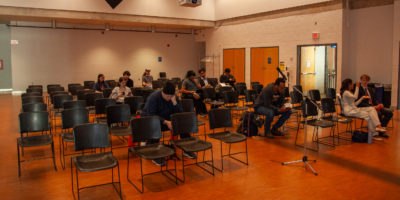By Kevin Ritchie
Recent plans to construct three new buildings at Ryerson will make room for thousands of new students, but those who need a place to find one near school.
Ryerson received $54-million from the provincial government’s SuperBuild fund to construct a centre for engineering and computer science, a graphics communication management building and a centre for community health. These buildings will make room for 3,350 new students in 2003.
Currently about 22 per cent of Ryerson’s students live downtown. If the same percentage of new students want to live downtown after the buildings are complete, several hundred more students will be looking for a place to live in a very unfriendly housing market.
SuperBuild projects at other colleges and universities in the GTA will also open up spots for an additional 26,536 students. Some of these new students will be looking to live downtown, making the housing hunt even more difficult and more expensive than it is now.
“I think it’s a very valid concern,” Ryerson president Claude Lajeunesse said. “Providing housing to first-year students has been a problem.”
Ryerson housing manager Liza Nassim said Ryerson is considering two solutions to the problem. One of the ways is to give the off-campus housing registry a permanent office in Pitman Hall with a part-time employee to help students search for accommodations. She is also looking at forming off-campus partnerships with property owners in the downtown area.
“It comes down to a question of finances,” Nassim sid.
Ross Peterson, a Toronto city planner, said finding housing downtown is already difficult.
“The housing situation is tight.”
The vacancy rate for the core is 0.8 per cent, or eight available apartments for every one thousand people.
“Right now we don’t see a lot of real housing coming on stream,” Peterson said, adding students will be forced to look outside the core for a place to live.
George Brown College expects 1,800 new students in 2003. Vice-President Robert Struthers said the school will focus on expanding and improving its housing services. George Brown does not have student residences, so the 25 per cent of students who live outside the GTA use the housing service.
Vacancy is not the only housing issue. Students seeking housing will have to contend with rising rental fees as well, said Bob Bezanson, chair of the Federation of Metro Tenants Association.
“It’s a landlord’s market,” he said. “Last year was pure hell, this year is going to be even worse.”
Under the Tenants Protection Amendment Act, Bezanson sai, landlords can charge tenants as much money as they want.
However, Bezanson is hopeful that by 2003—the deadline universities have to erect the new buildings—the housing situation in Toronto will have improved. He said if a protest at Queen’s Park in August is successful, it will get better.
Also, a bylaw to legalize and regulate basement apartments in Toronto may alleviate the housing crunch. Peterson said the bylaw would encourage people with space to spare to take on tenants.
Bezanson advises universities to look at all possible housing alternatives. “If you don’t meet the needs of your students,” he said. “The students will eventually go elsewhere.”
Lajeunesse agrees.
“I’m really pleased that we’ve invested money in the past for Pitman Hall and to have the [International Living and Learning Centre], he said. “Because without those, we would not be able to compete for students.
Or, as Bezanson says, “Dollars talk.”









Leave a Reply